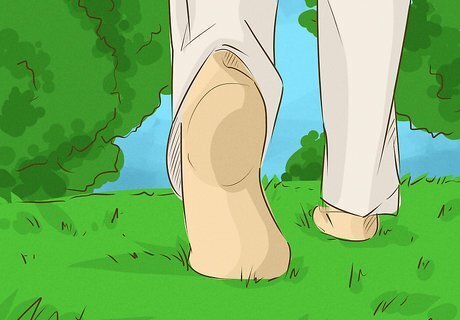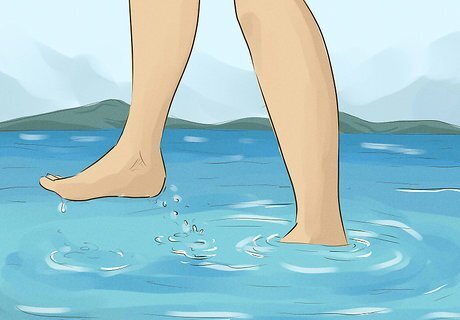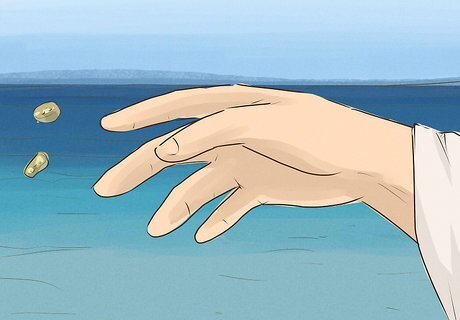
views
Finding a Suitable Location

Look for a natural body of water that you can access easily. Tashlich requires that you cast your sins into a body of water like a river, spring, lake, pond, or well. Most people prefer natural, flowing bodies of water because it gives the effect of your sins being swept away by the current, as God promised. If you’re having trouble finding a place to perform Tashlich, talk to your Rabbi about potential places near the synagogue or your hometown. They might be able to direct you to a place within walking distance. If you don’t live near a natural body of water and can’t manage to get to one, it’s acceptable to use running water from a hose or faucet. It’s acceptable to perform Tashlich even if you can only see the river from a distance.

Opt for a body of water that has fish living in it if you can. Fish are extremely symbolic for the practice of Tashlich for a number of reasons. Most importantly, fish can sometimes be unintentionally caught in nets, which symbolizes the tendency of humans to unknowingly get caught in bad situations. When you cast your sins into the water, the fish will protect them from evil because they are hidden under the water. If you can’t find a body of water with fish, or you aren’t sure if fish are present, it is still acceptable to perform Tashlich.

Ensure that you can get to the water after Mincha during Rosh Hashanah. Tashlich is supposed to be performed on the first or second day of Rosh Hashanah., preferably directly after Mincha. However, if you’re unable to perform the ceremony at that time, Tashlich can be done any day during Rosh Hashanah until Yom Kippur. If you miss the opportunity to perform Tashlich during Rosh Hashanah, you will have to wait until the following year.
Practicing Introspection

Examine what you’ve struggled with in the past year before doing Tashlich. Rosh Hashanah is a period of self-introspection, and Tashlich requires that you review your behavior over the last year before you can cast away your sins. Remember that everyone struggles with mistakes, sins, and accidents, so don’t be afraid to be honest with yourself during this period of review. For some people, it’s helpful to make a list of things that stand out to them during their review. This can be repetitive behaviors, negative acts that they don’t want to repeat, or even good things that they want to do more often over the year. If you’re having a particularly hard time with your introspection, talk to your Rabbi about what’s bothering you. They might have some advice on how to prepare yourself to relinquish the mistakes and sins of the previous year.

Take a meditation walk. After you’ve thought about your actions over the past year, take some time to consider how you can improve in the upcoming year. Many Jews recommend taking a walk and meditating to think of with ways that you can change your behavior and return to God in the next year. It’s important to keep in mind that the goal of Tashlich is to move forward in the year, rather than dwell on the past.

Read the passages of Tashlich. The source passage for Tashlich comes from the last verses of the prophet Micah (7:19). These verses tell the story of why the Jewish people practice Tashlich and will guide your own practice. Some communities also focus on passages in Psalms, such as sections 33, 118, and 130 to encourage further introspection.
Performing Tashlich

Collect your “sins” in your pockets. Some people choose to put bread crumbs or pieces of rice in their pockets to act as physical symbols of their sins. During the ceremony, it can be helpful to have something to throw in the water, rather than using your imagination. Some Rabbis discourage the tossing of breadcrumbs because it stems from superstitious practices. However, it can be helpful to visualize the sins being washed away, especially for young people. If you’re going to a natural body of water, never use paper or other items to represent your sins. These can cause pollution and damage the natural wildlife in the area. It’s okay to use paper if you’re using a small basin in your home.

Walk to the body of water or basin. Some synagogues perform this trip in large numbers, walking from the synagogue to the water. You can do this alone, as well, and take the time during the walk to think about your past year and what you’d like to do better in the upcoming year. Try to avoid becoming distracted during your walk, but be careful. If the body of water that you’re walking to is in a wooded area, watch your step. For older people practicing Tashlich, you may want to try to get as close to the water as possible with a car before walking.

Chant if you feel it’s appropriate. If a Rabbi is leading you to the water, they might chant about the practice of Tashlich, relinquishing sins, and starting anew. During that time, you can remain quiet and meditate on your sins, or you can join in the chanting. Once you get to the water, the chanting will normally stop except for the person leading the group. If you don’t feel comfortable chanting, that’s okay. You’re free to perform Tashlich however you feel comfortable, even if it means being a bit quieter than the rest of your group.

Say a small prayer about your previous struggles and hope for the year. This can be a very difficult part of Tashlich. At the water, stop and talk to God out loud or in your head about your past year and how you plan to do better. Try to be as honest as possible about what has happened during the year and how you want to improve. Many people struggle with this portion of the ceremony because they feel like they have to promise to be perfect. However, all you have to do is be honest about your abilities, admit to your mistakes, and strive to be better.

Cast your sins into the body of water. After your prayer, reach into your pockets and grab the breadcrumbs or metaphorical sins, and throw them into the water. When you let go of them, breathe out and watch them wash away. Only cast your sins away when you feel ready. It might take you longer than some other people to prepare for this moment, but don’t feel rushed. The people who are with you will understand what an emotional moment this can be.
















Comments
0 comment